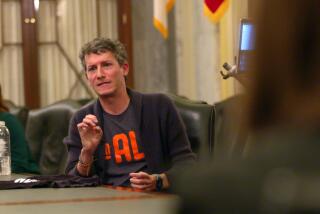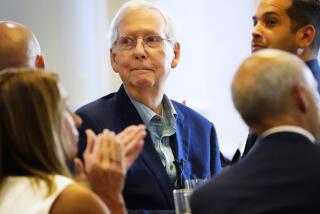Life’s Work Foreshadows Doctor’s Own Diagnosis
- Share via
SAN FRANCISCO — Dr. Richard Olney knows nearly all there is to know about amyotrophic lateral sclerosis, Lou Gehrig’s disease.
He knows that over a couple of years, it destroys nerves that control muscles, gradually entombing the mind alive in a useless body until, unable to move, speak, swallow or breathe, the patient perishes.
The founder of the ALS clinic at UC San Francisco and a national figure in the protracted war of research against the mysterious ailment, Olney knows it strikes a victim without warning in the bloom of adulthood.
As a physician noted for the exceptional compassion he shows his patients, Olney also knows the sorrow and dread they and their families must bear.
All this knowledge, Olney says, is a comfort now that ALS is ushering him toward his own death, probably in a matter of months.
The disease has tightened its grip on him with unusual speed, as if in revenge. It has consigned the 57-year-old runner, bicyclist and hiker to a wheelchair, but it can’t surprise him or deter him from trying to make the most of his remaining life.
“Maybe a small part of me resents that I’m dying at a relatively young age,” he says in a voice the disease has made slow and thin. “But whenever I starting thinking of getting it at 55, I think of all the people I have known who have gotten it in their 20s, 30s and 40s.”
In May 2003, Olney’s right knee began buckling. Olney thought it was related to an old running injury and, given his work, also considered the remote possibility it might be ALS.
That July, however, doctors discovered a herniated disk that seemed the cause of the knee trouble, and over the next nine months, Olney underwent three increasingly invasive back surgeries. Afterward, the knee seemed to improve.
Then in May 2004, while he was working out with dumbbells, his right arm started to spasm. The next month, a colleague at the university diagnosed ALS.
Olney was known among the young physicians who came to UC San Francisco to learn from him as a soft-spoken, matter-of-fact teacher. No matter how ironic his fate seems to others, he regards it in a practical and analytical way.
Every year, one of every 50,000 Americans is diagnosed with the disease, which is not contagious. A person’s lifetime risk is about one in 1,000. Given the number of people working in the ALS field, Olney estimates, one of them should come down with the disease every five to 10 years. No one among ALS researchers and caregivers interviewed, however, knows of any other of their number who’s been afflicted.
Understanding the disease as well as he does, Olney, with the help of his wife, Paula, lost no time acquiring the equipment that would make his life more tolerable as his ALS progressed.
They had a wheelchair ramp built at their ranch house in the Marin County city of Corte Madera. They bought a van equipped with hand controls from the family of one of Olney’s deceased patients. They had a ceiling track installed from their bedroom to the bathroom in anticipation of the day when he would have to be moved in a sling. They acquired a bed that would automatically turn him when he could no longer turn himself. They bought a motorized wheelchair.
The disease quickly dominated his life. Late last summer, Olney relinquished the directorship of the ALS clinic to a protege, Dr. Catherine Lomen-Hoerth.
In late September and early October, while his speech was still relatively steady and strong, he spent 15 hours recording almost 1,700 phrases and sentences in a pair of computer voice programs. They were mostly personal statements -- “Please tell me if you don’t understand what I am saying” and “I have Lou Gehrig’s disease and cannot speak clearly” and “I love you, Paula” -- for playback after he loses the ability to speak.
By last Thanksgiving, he no longer could manipulate the controls of the van. By Christmas, dragging himself 20 yards on a walker took half an hour.
At night he uses a face mask that’s part of a device that ensures he receives enough oxygen while asleep.
Of special concern to Lomen-Hoerth, Olney’s personal physician, was the speed with which his breathing power declined. Over about four months, it had dropped from 122% of normal to 80%, about three times faster than expected and a grim indicator of how much longer he has to live.
“When breathing gets down to 50%, we usually call hospice in, and after that, it’s not likely a person will live six months,” Lomen-Hoerth says.
These days, Olney’s 5-foot, 10-inch, 190-pound frame must be fitted into the ceiling-hung sling to be ferried from bed to bathroom. Olney can still feed himself, but swallowing thin liquid, which requires a great deal of throat-muscle control, has become difficult.
His ability to speak has declined markedly in the last month, and he soon may have to rely on the computer programs to give voice to his thoughts.
Before his diagnosis, Olney wrote a protocol for a new clinical study in which ALS patients would take a combination of an anti-HIV drug and an anti-cancer drug. After he learned he had ALS, he was the first patient to volunteer for the study and was designated “Patient 001.” He received his first dose a few weeks ago.
Neither Olney nor his doctor will be told if he’s receiving the drugs or placebos. Earlier this month, however, Lomen-Hoerth found that the precipitous decline in Olney’s breathing capacity seems to have been arrested, at least temporarily.
Olney has given lie to the adage that doctors make the worst patients. With the assistance of family members, he keeps to a healthful diet, stretches daily to ward off stiffness and does regular breathing exercises to keep his diaphragm muscle from atrophying. He travels to UC San Francisco three times a week to work with a trainer at the university’s Neurofit center, a rehab facility for neurology patients.
Afterward, he often drops in at the clinic he founded to greet colleagues and serve as an example to other ALS patients, some of whom remember him as their fit and energetic physician.
“I always feel very uplifted after he’s been here,” says Lomen-Hoerth. “I think he’s doing a lot to keep us cheered up. Rick and his family aren’t thinking just of themselves, but I think they’re taking care of us, like we’re family.”
ALS has been as transformative a force on Rick Olney’s family as on his body. A case in point is his son.
While in college at UC San Diego, Nick Olney wanted to be different from his father. He majored in both biochemistry and theater, and he wrote, produced and performed in a couple of plays at small theaters in San Diego and Los Angeles.
The creative life was a powerful lure. Although the thought of becoming a doctor appealed to his scientific bent, caring for sick people held no attraction for a young man who admits to being “kind of queasy and picky.”
Nick, 27, had just arrived for a visit with his sister Amy, a graduate student in Seattle, last May when she handed him the phone. Their father was on the line. The ALS that had been hovering in the background of everyone’s mind had taken center stage.
Nick left his job at a San Diego biotechnical company and moved home. Amy soon followed, transferring to Merritt College in Oakland. As his father’s debilities mounted, Nick found himself taking over for his mother every night. He helped his father do stretching exercises. He helped him shower and use the toilet. To his own surprise, he found that he had a talent for hands-on care.
“I realized what I thought would be the bad part of being a doctor was really the good part,” Nick says. “Taking care of my dad has helped me get rid of the heebie-jeebies. There’s a lot of stuff I’m doing with my dad that, talk to me two years ago -- I mean, helping somebody go to the bathroom -- and I’d have never thought I’d ever do it.”
Now Nick is studying for the medical school entrance examination and volunteers at the Haight Ashbury Free Medical Clinic in San Francisco, helping take care of ill homeless people.
His goal of writing movies has given way to becoming a doctor who does research and treats ALS patients, much as his father did. “It will be a way of keeping him close to me,” he says.
Nick admits to getting emotional whenever his father passes another milestone of disability, such as being unable to walk, being unable to drive. He particularly dreads the day when his father has to resort to the computerized voice programs.
Meanwhile, Paula Olney, a sunny and ebullient woman of 53, a dialysis nurse who’s been married for 30 years, struggles with the thousand and one melancholy details of putting her husband’s affairs in order, she says, of shutting down a career and a life.
“Life is overwhelming at the moment,” she says. “I try to get some pleasure out of each day. I don’t look forward because I get too scared. I don’t look back because it’s too sad. So I put one foot in front of the other. I’m scared to death. I can’t imagine my life without him.... But by the time he’s ready to go, I’m sure we’ll be ready to let him, because there’s nothing more painful than watching him go downhill every day.”
For now, the family still enjoys trips to the movies, the more fantastic and action-packed the better (someone must feed Rick popcorn, however, because he can no longer dip his hand into a container). They also can take day trips to such nature preserves as Point Reyes National Seashore, where Rick has covered as much as eight miles in his wheelchair.
Rick says he will not for a couple of months have a reliable indication of how quickly death will come. That tale will be foretold by the rate at which his breathing and swallowing deteriorate.
From now until the end, he says, he will relish the care his family lavishes on him. Although he will accept a feeding tube when he loses the ability to eat, he will refuse to be placed on a ventilator, even though doing so could keep him alive for years. Instead, he will deliver himself to hospice care.
Low levels of morphine will soften any anxieties. Sleeping pills will ensure slumber. One night he will drift into a peaceful sleep and not awake.
*
(BEGIN TEXT OF INFOBOX)
Lou Gehrig’s disease
The illness that ended the career and ultimately the life of baseball legend Lou Gehrig is a fatal neuromuscular disease called amyotrophic lateral sclerosis.
* About 5,600 new cases of ALS are diagnosed each year in the U.S., striking one in 50,000 Americans. About an equal number die of the disease each year.
* As many as 30,000 Americans may have ALS at any given time.
* The disease usually appears between ages 40 and 70; the peak age is about 55.
Source: ALS Assn.






